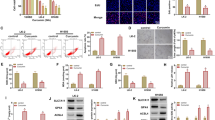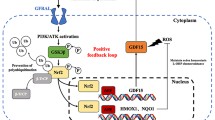Abstract
Radioresistance is one of the major barriers to improve the survival rate of breast cancer patients. Cyclooxygenase 2 (COX-2) is usually overexpressed in highly invasive and metastatic breast cancer, which may indicate an association with breast cancer radioresistance. The function role of COX-2 was investigated by using a radioresistant breast cancer cell line MDA-MB-231/RR10 and its parental cell line MDA-MB-231 cells before or after COX-2 was silenced by a specific small hairpin RNA (shRNA). The cell proliferation, migration, invasion, colony formation, and apoptosis were measured by CCK-8, scratch-wound, transwell, clone formation assay, and flow cytometry. Protein and mRNA expression were analyzed by Western blot and quantitative reverse transcriptase-polymerase chain reaction. COX-2 is upregulated in MDA-MB-231/RR10 cells compared with in MDA-MB-231 cells, and silencing of COX-2 expression by shRNA in MDA-MB-231/RR10 cells decreases the expression of Bcl-2 and Bcl-XL, but increases the proapoptotic protein BAK, leading to the increased apoptosis following treatment with γ-irradiation in comparison with those in control cells. Silencing of COX-2 also increases the expression of β-catenin and E-cadherin, two anti-invasion proteins, resulting in reduced cell migration and invasion tested by transwell chambers and wound-healing assays. Further study demonstrated that COX-2-induced radioresistance is negatively regulated through the phosphorylation of p38 at Tyr182, and that the phosphorylation of p38 induced by TNF-alpha reduces the expression of Bcl-2, BCL-XL, but increases β-catenin and E-cadherin, leading to the decreased invasiveness of cells. Our data suggest that COX-2, p38, Bcl-2, Bcl-XL, β-catenin, and E-cadherin may be considered as potential therapeutic targets against radioresistant breast cancer.






Similar content being viewed by others
References
Jemal A, Bray F, Center MM, Ferlay J, Ward E, Forman D. Global cancer statistics. CA Cancer J Clin. 2011;61:69–90.
Soderlund K, Perez-Tenorio G, Stal O. Activation of the phosphatidylinositol 3-kinase/Akt pathway prevents radiation-induced apoptosis in breast cancer cells. Int J Oncol. 2005;26:25–32.
Clarke M, Collins R, Darby S, Davies C, Elphinstone P, Evans E, et al. Effects of radiotherapy and of differences in the extent of surgery for early breast cancer on local recurrence and 15-year survival: an overview of the randomised trials. Lancet. 2005;366:2087–106.
Ahmed KM, Dong S, Fan M, Li JJ. Nuclear factor-kappab p65 inhibits mitogen-activated protein kinase signaling pathway in radioresistant breast cancer cells. Mol Cancer Res. 2006;4:945–55.
Kunigal S, Lakka SS, Joseph P, Estes N, Rao JS. Matrix metalloproteinase-9 inhibition down-regulates radiation-induced nuclear factor-kappa b activity leading to apoptosis in breast tumors. Clin Cancer Res. 2008;14:3617–26.
Diehn M, Cho RW, Lobo NA, Kalisky T, Dorie MJ, Kulp AN, et al. Association of reactive oxygen species levels and radioresistance in cancer stem cells. Nature. 2009;458:780–3.
Turner BC, Haffty BG, Narayanan L, Yuan J, Havre PA, Gumbs AA, et al. Insulin-like growth factor-i receptor overexpression mediates cellular radioresistance and local breast cancer recurrence after lumpectomy and radiation. Cancer Res. 1997;57:3079–83.
Duru N, Fan M, Candas D, Menaa C, Liu HC, Nantajit D, et al. Her2-associated radioresistance of breast cancer stem cells isolated from her2-negative breast cancer cells. Clin Cancer Res. 2012;18:6634–47.
No M, Choi EJ, Kim IA. Targeting her2 signaling pathway for radiosensitization: alternative strategy for therapeutic resistance. Cancer Biol Ther. 2009;8:2351–61.
Minn AJ, Gupta GP, Siegel PM, Bos PD, Shu W, Giri DD, et al. Genes that mediate breast cancer metastasis to lung. Nature. 2005;436:518–24.
Gupta GP, Nguyen DX, Chiang AC, Bos PD, Kim JY, Nadal C, et al. Mediators of vascular remodelling co-opted for sequential steps in lung metastasis. Nature. 2007;446:765–70.
Daneau G, Boidot R, Martinive P, Feron O. Identification of cyclooxygenase-2 as a major actor of the transcriptomic adaptation of endothelial and tumor cells to cyclic hypoxia: effect on angiogenesis and metastases. Clin Cancer Res. 2010;16:410–9.
Visscher DW, Pankratz VS, Santisteban M, Reynolds C, Ristimaki A, Vierkant RA, et al. Association between cyclooxygenase-2 expression in atypical hyperplasia and risk of breast cancer. J Natl Cancer Inst. 2008;100:421–7.
Lyons TR, O'Brien J, Borges VF, Conklin MW, Keely PJ, Eliceiri KW, et al. Postpartum mammary gland involution drives progression of ductal carcinoma in situ through collagen and COX-2. Nat Med. 2011;17:1109–15.
Hu M, Peluffo G, Chen H, Gelman R, Schnitt S, Polyak K. Role of COX-2 in epithelial-stromal cell interactions and progression of ductal carcinoma in situ of the breast. Proc Natl Acad Sci USA. 2009;106:3372–7.
Singh B, Berry JA, Shoher A, Ayers GD, Wei C, Lucci A. COX-2 involvement in breast cancer metastasis to bone. Oncogene. 2007;26:3789–96.
Chang SH, Liu CH, Conway R, Han DK, Nithipatikom K, Trifan OC, et al. Role of prostaglandin e2-dependent angiogenic switch in cyclooxygenase 2-induced breast cancer progression. Proc Natl Acad Sci USA. 2004;101:591–6.
Nix P, Lind M, Greenman J, Stafford N, Cawkwell L. Expression of COX-2 protein in radioresistant laryngeal cancer. Ann Oncol. 2004;15:797–801.
Chang HW, Roh JL, Jeong EJ, Lee SW, Kim SW, Choi SH, et al. Wnt signaling controls radiosensitivity via cyclooxygenase-2-mediated Ku expression in head and neck cancer. Int J Cancer. 2008;122:100–7.
Li JY, Li YY, Jin W, Yang Q, Shao ZM, Tian XS. ABT-737 reverses the acquired radioresistance of breast cancer cells by targeting Bcl-2 and Bcl-xL. J Exp Clin Cancer Res. 2012;31:102.
Yang G, Rosen DG, Liu G, Yang F, Guo X, Xiao X, et al. Cxcr2 promotes ovarian cancer growth through dysregulated cell cycle, diminished apoptosis, and enhanced angiogenesis. Clin Cancer Res. 2010;16:3875–86.
Yang G, Rosen DG, Mercado-Uribe I, Colacino JA, Mills GB, Bast Jr RC, et al. Knockdown of p53 combined with expression of the catalytic subunit of telomerase is sufficient to immortalize primary human ovarian surface epithelial cells. Carcinogenesis. 2007;28:174–82.
Sun H, Xu B, Inoue H, Chen QM. P38 MAPK mediates COX-2 gene expression by corticosterone in cardiomyocytes. Cell Signal. 2008;20:1952–9.
Kim SO, Kundu JK, Shin YK, Park JH, Cho MH, Kim TY, et al. [6]-Gingerol inhibits COX-2 expression by blocking the activation of p38 MAP kinase and nf-kappaB in phorbol ester-stimulated mouse skin. Oncogene. 2005;24:2558–67.
Bulavin DV, Fornace Jr AJ. P38 MAP kinase’s emerging role as a tumor suppressor. Adv Cancer Res. 2004;92:95–118.
Demidov ON, Kek C, Shreeram S, Timofeev O, Fornace AJ, Appella E, et al. The role of the MKK6/p38 MAPK pathway in Wip1-dependent regulation of ErbB2-driven mammary gland tumorigenesis. Oncogene. 2007;26:2502–6.
Zafarana G, Bristow RG. Tumor senescence and radioresistant tumor-initiating cells (TICs): let sleeping dogs lie! Breast Cancer Res. 2010;12:111.
Larkins TL, Nowell M, Singh S, Sanford GL. Inhibition of cyclooxygenase-2 decreases breast cancer cell motility, invasion and matrix metalloproteinase expression. BMC Cancer. 2006;6:181.
Ristimaki A, Sivula A, Lundin J, Lundin M, Salminen T, Haglund C, et al. Prognostic significance of elevated cyclooxygenase-2 expression in breast cancer. Cancer Res. 2002;62:632–5.
Terakado N, Shintani S, Yano J, Chunnan L, Mihara M, Nakashiro K, et al. Overexpression of cyclooxygenase-2 is associated with radioresistance in oral squamous cell carcinoma. Oral Oncol. 2004;40:383–9.
Pyo H, Choy H, Amorino GP, Kim JS, Cao Q, Hercules SK, et al. A selective cyclooxygenase-2 inhibitor, ns-398, enhances the effect of radiation in vitro and in vivo preferentially on the cells that express cyclooxygenase-2. Clin Cancer Res. 2001;7:2998–3005.
Yoshida A, Sarian LO, Andrade LA, Pignataro F, Pinto GA, Derchain SF. Cell proliferation activity unrelated to COX-2 expression in ovarian tumors. Int J Gynecol Cancer. 2007;17:607–14.
Bundred NJ, Cramer A, Morris J, Renshaw L, Cheung KL, Flint P, et al. Cyclooxygenase-2 inhibition does not improve the reduction in ductal carcinoma in situ proliferation with aromatase inhibitor therapy: results of the erisac randomized placebo-controlled trial. Clin Cancer Res. 2010;16:1605–12.
Yu H, Mohan S, Natarajan M. Radiation-triggered NF-kappaB activation is responsible for the angiogenic signaling pathway and neovascularization for breast cancer cell proliferation and growth. Breast Cancer (Auckl). 2012;6:125–35.
Lagadec C, Vlashi E, Della Donna L, Meng Y, Dekmezian C, Kim K, et al. Survival and self-renewing capacity of breast cancer initiating cells during fractionated radiation treatment. Breast Cancer Res. 2010;12:R13.
Bulavin DV, Saito S, Hollander MC, Sakaguchi K, Anderson CW, Appella E, et al. Phosphorylation of human p53 by p38 kinase coordinates n-terminal phosphorylation and apoptosis in response to UV radiation. EMBO J. 1999;18:6845–54.
Bulavin DV, Higashimoto Y, Popoff IJ, Gaarde WA, Basrur V, Potapova O, et al. Initiation of a G2/M checkpoint after ultraviolet radiation requires p38 kinase. Nature. 2001;411:102–7.
Wen HC, Avivar-Valderas A, Sosa MS, Girnius N, Farias EF, Davis RJ, et al. P38alpha signaling induces anoikis and lumen formation during mammary morphogenesis. Sci Signal. 2011;4:ra34.
An J, Chervin AS, Nie A, Ducoff HS, Huang Z. Overcoming the radioresistance of prostate cancer cells with a novel Bcl-2 inhibitor. Oncogene. 2007;26:652–61.
Acknowledgments
Z. Ou was supported by National Natural Science Foundation of China (81172506) and by the Shanghai Committee of Science and Technology, China (grant no. 12DZ2260100); G. Yang was supported by Doctoral Fund of Ministry of Education of China (20120071110079), by Shanghai Pujiang Program (11PJ1402200) from Shanghai Municipal Government of China, and by National Nature Science Foundation of China (91129721).
Conflicts of interest
None
Author information
Authors and Affiliations
Corresponding authors
Rights and permissions
About this article
Cite this article
Lin, F., Luo, J., Gao, W. et al. COX-2 promotes breast cancer cell radioresistance via p38/MAPK-mediated cellular anti-apoptosis and invasiveness. Tumor Biol. 34, 2817–2826 (2013). https://doi.org/10.1007/s13277-013-0840-x
Received:
Accepted:
Published:
Issue Date:
DOI: https://doi.org/10.1007/s13277-013-0840-x




